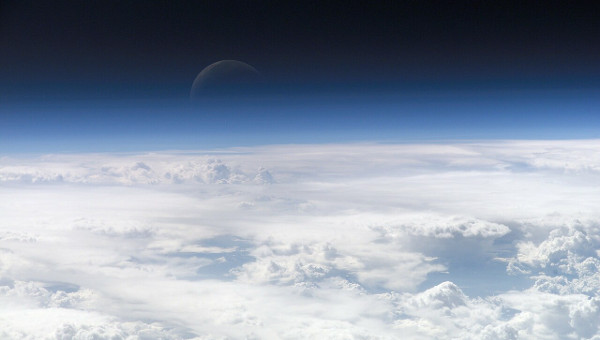We only need to spray 2kg of a particular powder, bismuth(III) iodide, high into the air weekly to cool the entire Earth to the point where we stay below 2°C with significantly reduced carbon dioxide emissions.
If this sounds too good to be true, it's actually a very optimistic description of the study's conclusions Intentional stratospheric drought (Intentional drying of the stratosphere). Water vapor is a greenhouse gas, contributed by water vapor in the stratosphere (the thin layer of air more than 17 kilometers high). Per kilo, water vapor in the stratosphere retains much more heat on Earth than water vapor in the atmosphere.
Very modest means
It will therefore be particularly effective in removing moisture from the stratosphere. While clearing the lower layers of air is just a matter of turning on a tap, because water from the oceans is constantly evaporating and mixing with the upper air, the air in the stratosphere continues to circulate around the Earth for years, with little exchange with the lower atmosphere.
A group of researchers from NASA and the National Oceanic and Atmospheric Administration (NOAA) are now evaluating the matter Advancement of science showed that the stratosphere could indeed become drier by very modest means. The trick is to use weather satellites to pinpoint places where moist air rises into the stratosphere, and seed them at an altitude of 17 kilometers with tiny salt crystals that promote ice formation. The researchers specifically mention bismuth(III) iodide, but there are also other substances that have this effect.
Air rising into the stratosphere often becomes supersaturated (because the temperature drops sharply), but in the absence of condensation nuclei (such as dust and salt crystals), moisture remains in the air in the form of water vapor, so the greenhouse effect disappears. Maintained. A small amount of condensation nuclei from bismuth(III) iodide ensures that water vapor largely condenses into ice crystals as it rises into the stratosphere. These ice crystals fall, thus removing moisture from the stratosphere.
They estimated the amount of bismuth(III) iodide needed for this purpose, which was surprisingly small: depending on how finely the powder was spread, a minimum of 2 kilos per week to a maximum of 2,000 kilos per week. Even 2,000 kilograms per week could easily be dispersed in a targeted manner by a few Global Hawk drones at this altitude.
Mother Earth
This plan is currently nothing more than a concept that must be developed and tested further. The researchers believe that this alone will not stop global warming, but it could make a useful contribution to a whole range of measures.
It will be difficult to get money to pursue this research, because this goes into the door Geological engineeringThis has a bad reputation within the environmental movement. Objections to geoengineering are largely ideological, or even mythical, in nature: we should not mess with Mother Earth. This is in the same way that genetic modification is rejected in advance “because man is not allowed to play God.”
Never in harmony with nature
The truth is that humanity has been playing the role of God since Adam and Eve. Soon HOmo sapiens The spread across the land from Africa began about a hundred thousand years ago, exterminating many animal species in all newly conquered lands. Not consciously, of course, but because our large brains made us efficient and deadly hunters.
Targeted burning of land, first to hunt prey and later to convert it to cropland, also led to humans' dominant influence on nature for tens of thousands of years. Moreover, the domestication of animals goes a long way: in short, you could say that our goats devoured the Middle East long before the year 0. Man has never lived in harmony with nature, and certainly not prehistoric man.
Humanity has now engaged in a unique geoengineering project for a century and a half by rapidly releasing large amounts of global warming gases into the atmosphere. Large-scale fertilizer production, through which we have been able to double the amount of nitrates and phosphates in the global plant nutrient cycle, can also be viewed as a large-scale geoengineering project. The previous project causes global warming. The other project works to combat global warming in part because nature on Earth grows quickly and absorbs a lot of extra carbon dioxide, thanks in part to these extra nutrients.
So there are good reasons not to evaluate proposals for geoengineering on an ideological level, but rather in a sober and rational manner. Unintended side effects are of course a risk associated with geoengineering, and we should take it seriously. Fertilization of the oceans with iron sulfide has previously been suggested. Most of the ocean is a kind of desert, mainly due to the micronutrient deficiency of iron. Iron fertilization can strongly promote the growth of algae, the base of the food pyramid in the oceans. They will then absorb much more carbon dioxide than they already do.
There is no iron enrichment
But are we sure that causing global algae blooms will only have beneficial effects? If that turns out not to be the case when you've already dumped a few million tons of iron sulfide into the ocean, you won't be able to get it out. So we probably won't fertilize with iron.
Drying out the stratosphere does not carry this risk, because it is reversible. If this had unintended side effects, we could simply stop deploying bismuth(III) iodide, and the stratosphere would become wetter again.
Fasten
Another frequently heard objection to geoengineering is the risk of lock-in: if you can counteract the thermal effects of CO2 with counter-cooling measures, and thus continue emitting CO2 as usual, you won't be able to stop it anymore. Without the greenhouse effect reaching the ceiling. . This is a real objection to forms of geoengineering that require enormous efforts and advanced technology, such as the idea of reflecting a small percentage of the sunlight that usually reaches Earth with large screens in space.
But this objection to the drying out of the stratosphere is unrealistic: once we are no longer able to keep a few large drones in the air, our society will deteriorate to the point where carbon dioxide emissions will decline as well.
The stupidest argument against geoengineering – but also against technology like CCS (permanently burying carbon dioxide underground) – is that it is an excuse to keep emitting carbon dioxide. In broad layers of the climate and environmental movement, eliminating fossil fuels is now a goal in itself and has little to do with combating climate change. Without fossil fuels, their virtue myth goes, our capitalist, neocolonial, and racially exploitative society is doomed to failure, which will then automatically be replaced by a renewable, compact, eco-friendly, all-inclusive paradise.
Keep all options open
It's no longer worth taking as seriously as Elon Musk's plan to start a terrestrial annex on Mars in case things get completely out of hand here. Common sense is, as is often the case, to realize that there is no single transcendent, creative solution. Also regarding climate change, we must keep everything open as an option, evaluate everything on its merits, and then do what is necessary. So, we have to work to reduce carbon dioxide emissions, but apply carbon dioxide capture and storage, apply safe geoengineering, and accept and adapt to a certain degree of global warming.
It is not grandiose and convincing, no one would stick to a highway or throw canned soup at a work of art: this has gradually become a useful criterion for assessing whether a policy can truly contribute to a better world.
Scientific journalist Arnot Jaspers Best-selling books Nitrogen trap. He will publish his new book next summer, about the energy transition in the Netherlands. Information for media and libraries: [email protected]
Winya weekCelebrates its fifth anniversary. Wynia Week is made possible by the voluntarily paid subscriptions of readers, viewers and listeners. Will you actually participate – also in 2024?

“Total coffee specialist. Hardcore reader. Incurable music scholar. Web guru. Freelance troublemaker. Problem solver. Travel trailblazer.”







More Stories
Men and menopause: From hidden conflict to open conversation
Express your opinion about the design of the public space
The World Health Organization criticizes unnecessary antibiotic treatments during the Corona crisis